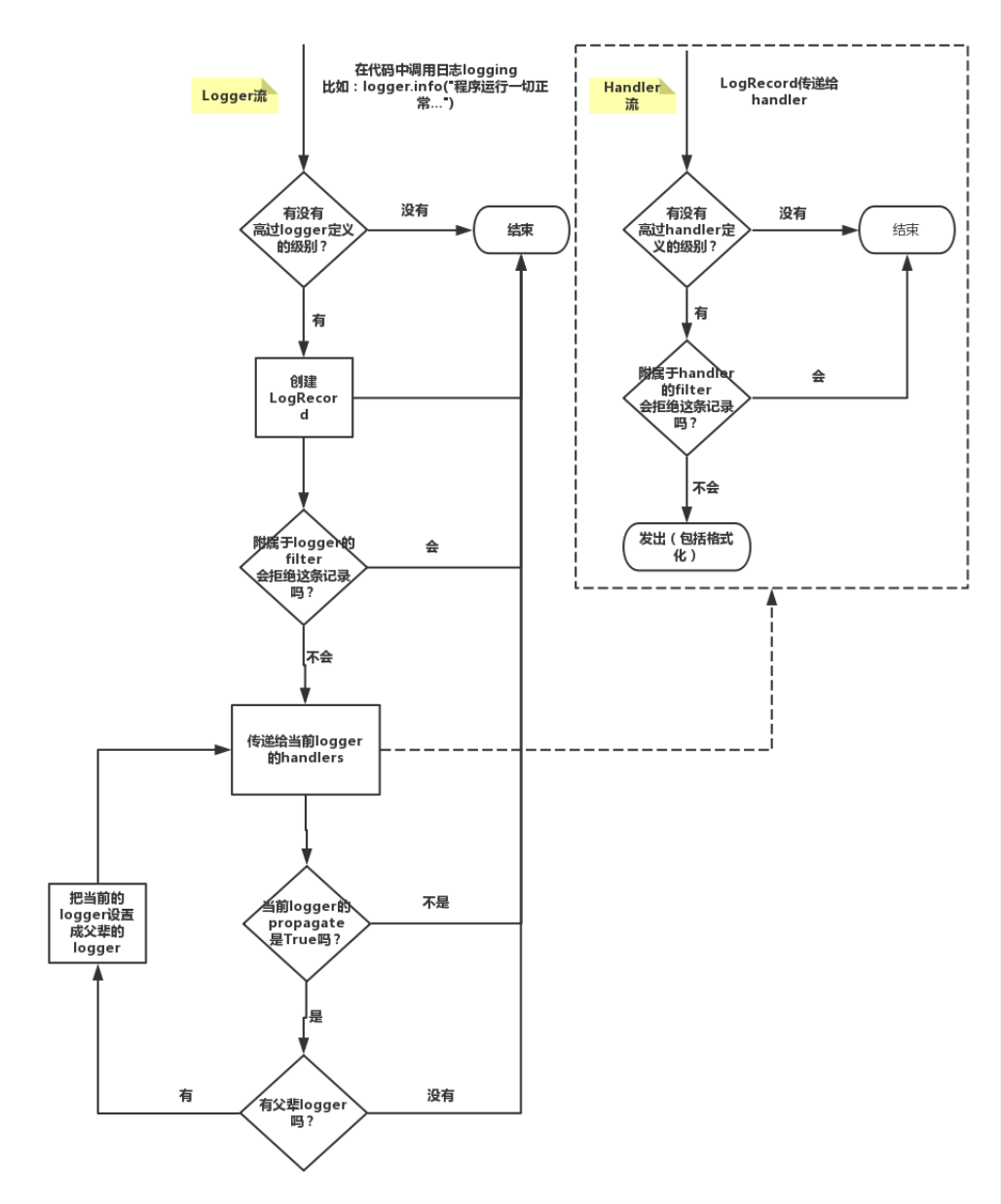python教程系列(三.2.8、log模組)
阿新 • • 發佈:2019-01-13

CRITICAL = 50 #FATAL = CRITICAL
ERROR = 40
WARNING = 30 #WARN = WARNING
INFO = 20
DEBUG = 10
NOTSET = 0 #不設定
import logging logging.debug('除錯debug') logging.info('訊息info') logging.warning('警告warn') logging.error('錯誤error') logging.critical('嚴重critical') ''' WARNING:root:警告warn ERROR:root:錯誤error CRITICAL:root:嚴重critical '''
可在logging.basicConfig()函式中通過具體引數來更改logging模組預設行為,可用引數有 filename:用指定的檔名建立FiledHandler(後邊會具體講解handler的概念),這樣日誌會被儲存在指定的檔案中。 filemode:檔案開啟方式,在指定了filename時使用這個引數,預設值為“a”還可指定為“w”。 format:指定handler使用的日誌顯示格式。 datefmt:指定日期時間格式。 level:設定rootlogger(後邊會講解具體概念)的日誌級別 stream:用指定的stream建立StreamHandler。可以指定輸出到sys.stderr,sys.stdout或者檔案,預設為sys.stderr。若同時列出了filename和stream兩個引數,則stream引數會被忽略。 #格式 %(name)s:Logger的名字,並非使用者名稱,詳細檢視 %(levelno)s:數字形式的日誌級別 %(levelname)s:文字形式的日誌級別 %(pathname)s:呼叫日誌輸出函式的模組的完整路徑名,可能沒有 %(filename)s:呼叫日誌輸出函式的模組的檔名 %(module)s:呼叫日誌輸出函式的模組名 %(funcName)s:呼叫日誌輸出函式的函式名 %(lineno)d:呼叫日誌輸出函式的語句所在的程式碼行 %(created)f:當前時間,用UNIX標準的表示時間的浮 點數表示 %(relativeCreated)d:輸出日誌資訊時的,自Logger建立以 來的毫秒數 %(asctime)s:字串形式的當前時間。預設格式是 “2003-07-08 16:49:45,896”。逗號後面的是毫秒 %(thread)d:執行緒ID。可能沒有 %(threadName)s:執行緒名。可能沒有 %(process)d:程序ID。可能沒有 %(message)s:使用者輸出的訊息
format引數中可能用到的格式化串: %(name)s Logger的名字 %(levelno)s 數字形式的日誌級別 %(levelname)s 文字形式的日誌級別 %(pathname)s 呼叫日誌輸出函式的模組的完整路徑名,可能沒有 %(filename)s 呼叫日誌輸出函式的模組的檔名 %(module)s 呼叫日誌輸出函式的模組名 %(funcName)s 呼叫日誌輸出函式的函式名 %(lineno)d 呼叫日誌輸出函式的語句所在的程式碼行 %(created)f 當前時間,用UNIX標準的表示時間的浮 點數表示 %(relativeCreated)d 輸出日誌資訊時的,自Logger建立以 來的毫秒數 %(asctime)s 字串形式的當前時間。預設格式是 “2003-07-08 16:49:45,896”。逗號後面的是毫秒 %(thread)d 執行緒ID。可能沒有 %(threadName)s 執行緒名。可能沒有 %(process)d 程序ID。可能沒有 %(message)s使用者輸出的訊息 #========使用 import logging logging.basicConfig(filename='access.log', format='%(asctime)s - %(name)s - %(levelname)s -%(module)s: %(message)s', datefmt='%Y-%m-%d %H:%M:%S %p', level=10) logging.debug('除錯debug') logging.info('訊息info') logging.warning('警告warn') logging.error('錯誤error') logging.critical('嚴重critical') #========結果 access.log內容: 2017-07-28 20:32:17 PM - root - DEBUG -test: 除錯debug 2017-07-28 20:32:17 PM - root - INFO -test: 訊息info 2017-07-28 20:32:17 PM - root - WARNING -test: 警告warn 2017-07-28 20:32:17 PM - root - ERROR -test: 錯誤error 2017-07-28 20:32:17 PM - root - CRITICAL -test: 嚴重critical part2: 可以為logging模組指定模組級的配置,即所有logger的配置
原理圖:

logger:產生日誌的物件
Filter:過濾日誌的物件
Handler:接收日誌然後控制列印到不同的地方,FileHandler用來列印到檔案中,StreamHandler用來列印到終端
Formatter物件:可以定製不同的日誌格式物件,然後繫結給不同的Handler物件使用,以此來控制不同的Handler的日誌格式
'''
critical=50
error =40
warning =30
info = 20
debug =10
'''
import logging
#1、logger物件:負責產生日誌,然後交給Filter過濾,然後交給不同的Handler輸出
logger=logging.getLogger(__file__)
#2、Filter物件:不常用,略
#3、Handler物件:接收logger傳來的日誌,然後控制輸出
h1=logging.FileHandler('t1.log') #列印到檔案
h2=logging.FileHandler('t2.log') #列印到檔案
h3=logging.StreamHandler() #列印到終端
#4、Formatter物件:日誌格式
formmater1=logging.Formatter('%(asctime)s - %(name)s - %(levelname)s -%(module)s: %(message)s',
datefmt='%Y-%m-%d %H:%M:%S %p',)
formmater2=logging.Formatter('%(asctime)s : %(message)s',
datefmt='%Y-%m-%d %H:%M:%S %p',)
formmater3=logging.Formatter('%(name)s %(message)s',)
#5、為Handler物件繫結格式
h1.setFormatter(formmater1)
h2.setFormatter(formmater2)
h3.setFormatter(formmater3)
#6、將Handler新增給logger並設定日誌級別
logger.addHandler(h1)
logger.addHandler(h2)
logger.addHandler(h3)
logger.setLevel(10)
#7、測試
logger.debug('debug')
logger.info('info')
logger.warning('warning')
logger.error('error')
logger.critical('critical')
[ ](javascript:void(0); “複製程式碼”)
](javascript:void(0); “複製程式碼”)
logger是第一級過濾,然後才能到handler,我們可以給logger和handler同時設定level,但是需要注意的是

[ ](javascript:void(0); “複製程式碼”)
](javascript:void(0); “複製程式碼”)
Logger is also the first to filter the message based on a level — if you set the logger to INFO, and all handlers to DEBUG, you still won't receive DEBUG messages on handlers — they'll be rejected by the logger itself. If you set logger to DEBUG, but all handlers to INFO, you won't receive any DEBUG messages either — because while the logger says "ok, process this", the handlers reject it (DEBUG < INFO).
#驗證
import logging
form=logging.Formatter('%(asctime)s - %(name)s - %(levelname)s -%(module)s: %(message)s',
datefmt='%Y-%m-%d %H:%M:%S %p',)
ch=logging.StreamHandler()
ch.setFormatter(form)
# ch.setLevel(10)
ch.setLevel(20)
l1=logging.getLogger('root')
# l1.setLevel(20)
l1.setLevel(10)
l1.addHandler(ch)
l1.debug('l1 debug')
[ ](javascript:void(0); “複製程式碼”)
](javascript:void(0); “複製程式碼”)

[ ](javascript:void(0); “複製程式碼”)
](javascript:void(0); “複製程式碼”)
import logging
formatter=logging.Formatter('%(asctime)s - %(name)s - %(levelname)s -%(module)s: %(message)s',
datefmt='%Y-%m-%d %H:%M:%S %p',)
ch=logging.StreamHandler()
ch.setFormatter(formatter)
logger1=logging.getLogger('root')
logger2=logging.getLogger('root.child1')
logger3=logging.getLogger('root.child1.child2')
logger1.addHandler(ch)
logger2.addHandler(ch)
logger3.addHandler(ch)
logger1.setLevel(10)
logger2.setLevel(10)
logger3.setLevel(10)
logger1.debug('log1 debug')
logger2.debug('log2 debug')
logger3.debug('log3 debug')
'''
2017-07-28 22:22:05 PM - root - DEBUG -test: log1 debug
2017-07-28 22:22:05 PM - root.child1 - DEBUG -test: log2 debug
2017-07-28 22:22:05 PM - root.child1 - DEBUG -test: log2 debug
2017-07-28 22:22:05 PM - root.child1.child2 - DEBUG -test: log3 debug
2017-07-28 22:22:05 PM - root.child1.child2 - DEBUG -test: log3 debug
2017-07-28 22:22:05 PM - root.child1.child2 - DEBUG -test: log3 debug
'''
[ ](javascript:void(0); “複製程式碼”)
](javascript:void(0); “複製程式碼”)

[ ](javascript:void(0); “複製程式碼”)
](javascript:void(0); “複製程式碼”)
"""
logging配置
"""
import os
import logging.config
# 定義三種日誌輸出格式 開始
standard_format = '[%(asctime)s][%(threadName)s:%(thread)d][task_id:%(name)s][%(filename)s:%(lineno)d]' \
'[%(levelname)s][%(message)s]' #其中name為getlogger指定的名字
simple_format = '[%(levelname)s][%(asctime)s][%(filename)s:%(lineno)d]%(message)s'
id_simple_format = '[%(levelname)s][%(asctime)s] %(message)s'
# 定義日誌輸出格式 結束
logfile_dir = os.path.dirname(os.path.abspath(__file__)) # log檔案的目錄
logfile_name = 'all2.log' # log檔名
# 如果不存在定義的日誌目錄就建立一個
if not os.path.isdir(logfile_dir):
os.mkdir(logfile_dir)
# log檔案的全路徑
logfile_path = os.path.join(logfile_dir, logfile_name)
# log配置字典
LOGGING_DIC = {
'version': 1,
'disable_existing_loggers': False,
'formatters': {
'standard': {
'format': standard_format
},
'simple': {
'format': simple_format
},
},
'filters': {},
'handlers': {
#列印到終端的日誌
'console': {
'level': 'DEBUG',
'class': 'logging.StreamHandler', # 列印到螢幕
'formatter': 'simple'
},
#列印到檔案的日誌,收集info及以上的日誌
'default': {
'level': 'DEBUG',
'class': 'logging.handlers.RotatingFileHandler', # 儲存到檔案
'formatter': 'standard',
'filename': logfile_path, # 日誌檔案
'maxBytes': 1024*1024*5, # 日誌大小 5M
'backupCount': 5,
'encoding': 'utf-8', # 日誌檔案的編碼,再也不用擔心中文log亂碼了
},
},
'loggers': {
#logging.getLogger(__name__)拿到的logger配置
'': {
'handlers': ['default', 'console'], # 這裡把上面定義的兩個handler都加上,即log資料既寫入檔案又列印到螢幕
'level': 'DEBUG',
'propagate': True, # 向上(更高level的logger)傳遞
},
},
}
def load_my_logging_cfg():
logging.config.dictConfig(LOGGING_DIC) # 匯入上面定義的logging配置
logger = logging.getLogger(__name__) # 生成一個log例項
logger.info('It works!') # 記錄該檔案的執行狀態
if __name__ == '__main__':
load_my_logging_cfg()
[ ](javascript:void(0); “複製程式碼”)
](javascript:void(0); “複製程式碼”)

[ ](javascript:void(0); “複製程式碼”)
](javascript:void(0); “複製程式碼”)
"""
MyLogging Test
"""
import time
import logging
import my_logging # 匯入自定義的logging配置
logger = logging.getLogger(__name__) # 生成logger例項
def demo():
logger.debug("start range... time:{}".format(time.time()))
logger.info("中文測試開始。。。")
for i in range(10):
logger.debug("i:{}".format(i))
time.sleep(0.2)
else:
logger.debug("over range... time:{}".format(time.time()))
logger.info("中文測試結束。。。")
if __name__ == "__main__":
my_logging.load_my_logging_cfg() # 在你程式檔案的入口載入自定義logging配置
demo()
注意注意注意:
#1、有了上述方式我們的好處是:所有與logging模組有關的配置都寫到字典中就可以了,更加清晰,方便管理
#2、我們需要解決的問題是:
1、從字典載入配置:logging.config.dictConfig(settings.LOGGING_DIC)
2、拿到logger物件來產生日誌
logger物件都是配置到字典的loggers 鍵對應的子字典中的
按照我們對logging模組的理解,要想獲取某個東西都是通過名字,也就是key來獲取的
於是我們要獲取不同的logger物件就是
logger=logging.getLogger('loggers子字典的key名')
但問題是:如果我們想要不同logger名的logger物件都共用一段配置,那麼肯定不能在loggers子字典中定義n個key
'loggers': {
'l1': {
'handlers': ['default', 'console'], #
'level': 'DEBUG',
'propagate': True, # 向上(更高level的logger)傳遞
},
'l2: {
'handlers': ['default', 'console' ],
'level': 'DEBUG',
'propagate': False, # 向上(更高level的logger)傳遞
},
'l3': {
'handlers': ['default', 'console'], #
'level': 'DEBUG',
'propagate': True, # 向上(更高level的logger)傳遞
},
}
#我們的解決方式是,定義一個空的key
'loggers': {
'': {
'handlers': ['default', 'console'],
'level': 'DEBUG',
'propagate': True,
},
}
這樣我們再取logger物件時
logging.getLogger(__name__),不同的檔案__name__不同,這保證了列印日誌時標識資訊不同,但是拿著該名字去loggers裡找key名時卻發現找不到,於是預設使用key=''的配置
另外一個django的配置,瞄一眼就可以,跟上面的一樣
# logging_config.py
LOGGING = {
'version': 1,
'disable_existing_loggers': False,
'formatters': {
'standard': {
'format': '[%(asctime)s][%(threadName)s:%(thread)d][task_id:%(name)s][%(filename)s:%(lineno)d]'
'[%(levelname)s][%(message)s]'
},
'simple': {
'format': '[%(levelname)s][%(asctime)s][%(filename)s:%(lineno)d]%(message)s'
},
'collect': {
'format': '%(message)s'
}
},
'filters': {
'require_debug_true': {
'()': 'django.utils.log.RequireDebugTrue',
},
},
'handlers': {
#列印到終端的日誌
'console': {
'level': 'DEBUG',
'filters': ['require_debug_true'],
'class': 'logging.StreamHandler',
'formatter': 'simple'
},
#列印到檔案的日誌,收集info及以上的日誌
'default': {
'level': 'INFO',
'class': 'logging.handlers.RotatingFileHandler', # 儲存到檔案,自動切
'filename': os.path.join(BASE_LOG_DIR, "xxx_info.log"), # 日誌檔案
'maxBytes': 1024 * 1024 * 5, # 日誌大小 5M
'backupCount': 3,
'formatter': 'standard',
'encoding': 'utf-8',
},
#列印到檔案的日誌:收集錯誤及以上的日誌
'error': {
'level': 'ERROR',
'class': 'logging.handlers.RotatingFileHandler', # 儲存到檔案,自動切
'filename': os.path.join(BASE_LOG_DIR, "xxx_err.log"), # 日誌檔案
'maxBytes': 1024 * 1024 * 5, # 日誌大小 5M
'backupCount': 5,
'formatter': 'standard',
'encoding': 'utf-8',
},
#列印到檔案的日誌
'collect': {
'level': 'INFO',
'class': 'logging.handlers.RotatingFileHandler', # 儲存到檔案,自動切
'filename': os.path.join(BASE_LOG_DIR, "xxx_collect.log"),
'maxBytes': 1024 * 1024 * 5, # 日誌大小 5M
'backupCount': 5,
'formatter': 'collect',
'encoding': "utf-8"
}
},
'loggers': {
#logging.getLogger(__name__)拿到的logger配置
'': {
'handlers': ['default', 'console', 'error'],
'level': 'DEBUG',
'propagate': True,
},
#logging.getLogger('collect')拿到的logger配置
'collect': {
'handlers': ['console', 'collect'],
'level': 'INFO',
}
},
}
# 用法:拿到倆個logger
logger = logging.getLogger(__name__) #線上正常的日誌
collect_logger = logging.getLogger("collect") #領導說,需要為領導們單獨定製領導們看的日誌

